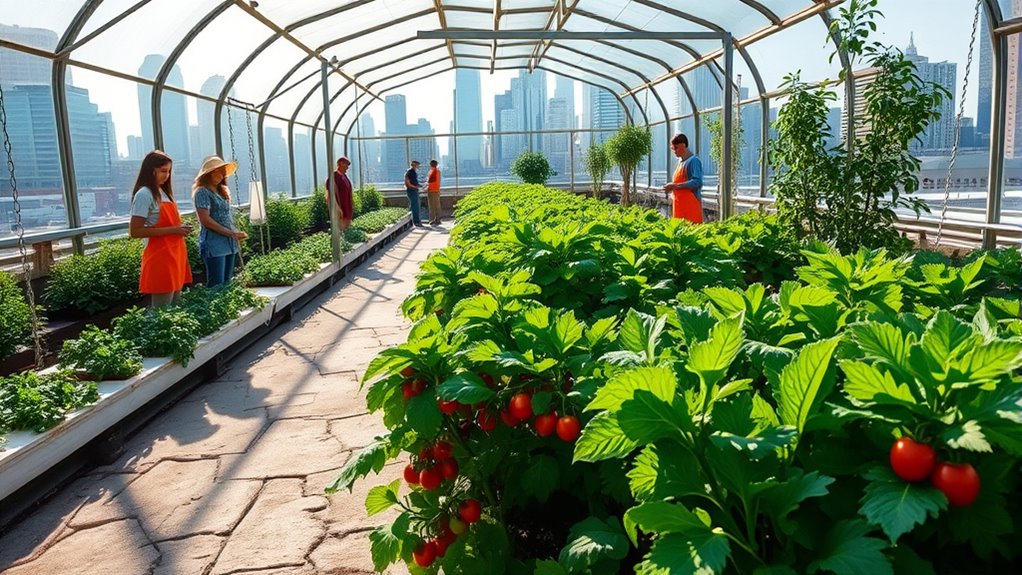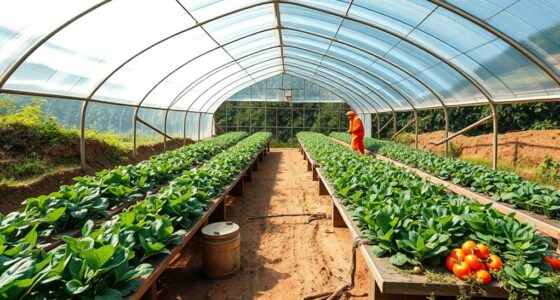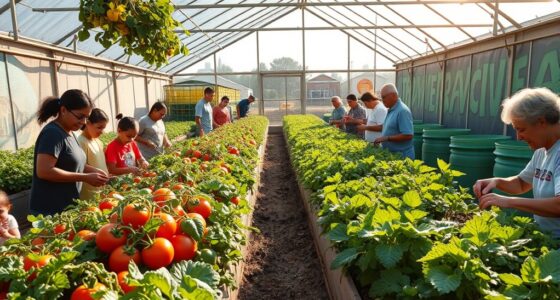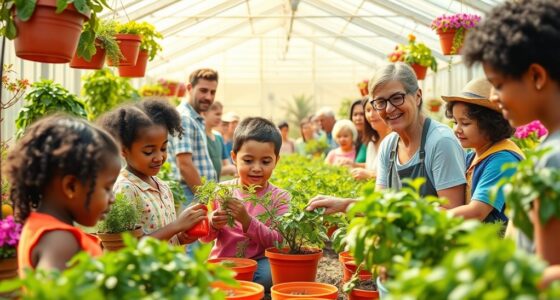Community greenhouses help directly address food insecurity by bringing fresh, affordable produce to underserved urban areas. They make efficient use of limited space, allowing you to cultivate vegetables, herbs, and fruits year-round. These spaces also serve as hubs for education, teaching sustainable gardening practices that empower local residents. By fostering social bonds and partnerships, community greenhouses strengthen resilience and guarantee healthy food access for all. Keep exploring to discover how these innovative solutions are transforming city neighborhoods.
Key Takeaways
- Community greenhouses provide underserved urban areas with local access to fresh, nutritious, and affordable produce, reducing food insecurity.
- They maximize land use by transforming vacant lots into productive spaces for year-round vegetable and herb cultivation.
- These greenhouses serve as educational hubs, teaching sustainable farming practices and encouraging healthier food choices.
- They foster social cohesion by involving residents in gardening, volunteering, and community activities, strengthening support networks.
- By promoting local food production, community greenhouses help build resilient urban food systems and reduce reliance on imported foods.

Community greenhouses are emerging as a practical solution to combat food insecurity in urban and underserved areas. These structures serve as hubs for urban agriculture, giving residents a hands-on way to grow fresh produce right in their neighborhoods. By focusing on local sourcing, community greenhouses reduce the need for long-distance transportation, which not only cuts costs but also guarantees that fresh, nutritious food remains accessible and affordable. When you participate in or support these greenhouses, you’re helping to build a more resilient local food system that responds directly to your community’s needs.
Supporting community greenhouses helps build resilient, local food systems that provide fresh, affordable produce in underserved neighborhoods.
In urban environments, space is often limited, making traditional farming challenging. Community greenhouses make efficient use of available land, transforming vacant lots or underutilized spaces into productive gardens. This approach allows residents to grow a variety of crops, including vegetables, herbs, and small fruits, all within a controlled environment that extends the growing season. As a result, you can access fresh produce year-round, even when local markets are scarce or prices are high. It’s a direct way to combat hunger while fostering local sourcing, which strengthens community ties and supports local economies.
When you get involved with a community greenhouse, you’re not just growing food—you’re also gaining knowledge about urban agriculture and sustainable practices. Many greenhouses operate as educational spaces, teaching residents about composting, water conservation, and organic farming methods. This education empowers you to make healthier food choices and reduces your reliance on processed or imported foods. Plus, by sourcing your produce locally, you’re decreasing your carbon footprint and supporting environmentally friendly practices that help fight climate change.
Community greenhouses also foster social cohesion, bringing together people of all ages and backgrounds around a shared goal. Whether you volunteer your time, participate in workshops, or simply buy fresh produce from the greenhouse, you’re contributing to a more equitable food system. These greenhouses often partner with local organizations, schools, and food banks, ensuring that fresh produce reaches those who need it most. This direct connection between growers and consumers creates a cycle of support and trust, making food more accessible for everyone.
In essence, community greenhouses are not just about growing food—they’re about cultivating community resilience. They empower you to take part in urban agriculture, promote local sourcing, and help address food insecurity at its roots. When you support or participate in these greenhouses, you’re investing in a healthier, more sustainable future, one where fresh, affordable food is a right, not a privilege.
Frequently Asked Questions
How Do Community Greenhouses Impact Local Economies?
Community greenhouses boost local economies by creating jobs and supporting small businesses, leading to greater economic benefits. They also foster social cohesion, encouraging residents to collaborate and strengthen community ties. When you participate in or support these greenhouses, you help stimulate economic activity and build a more connected, resilient neighborhood. These initiatives not only provide fresh produce but also contribute positively to the area’s financial and social well-being.
What Are the Initial Costs of Establishing a Community Greenhouse?
Starting a community greenhouse is like planting a seed for change. Your initial costs involve startup expenses such as land, soil, seeds, and equipment. Funding sources vary—you might seek grants, donations, or local sponsorships. These costs can range widely depending on size and scope, but planning carefully guarantees your green oasis grows steadily. Being resourceful with funding helps turn your vision into a thriving, sustainable community space.
How Do Greenhouses Address Nutritional Disparities in Urban Areas?
Greenhouses help address nutritional disparities in urban areas by promoting urban agriculture, making fresh produce more accessible. You can grow a variety of fruits and vegetables locally, reducing reliance on food deserts where healthy options are limited. This approach empowers communities to improve their diets, supports local food systems, and guarantees residents have better access to nutritious food, ultimately narrowing the gap caused by disparities in food availability.
What Challenges Do Community Greenhouses Face in Urban Environments?
You might think community greenhouses in urban areas face few hurdles, but zoning restrictions often limit their growth, making it hard to establish or expand. Water access is another challenge, as reliable supply is essential for healthy plant growth. These obstacles can slow progress and reduce impact. To succeed, you need to navigate local regulations carefully and guarantee consistent water availability, overcoming these barriers to bring green spaces and fresh produce to the community.
How Can Residents Be Encouraged to Participate in Greenhouse Programs?
You can encourage residents to participate in greenhouse programs by boosting volunteer engagement through appealing activities and clear benefits. Focus on educational outreach to inform residents about the positive impacts on the community and their personal growth. Offer workshops, events, and opportunities for hands-on involvement, making participation accessible and rewarding. When residents see the value and feel connected, they’ll be more motivated to join and support community greenhouses actively.
Conclusion
By supporting community greenhouses, you’re planting the seeds of change in urban food insecurity. These green havens act as lifelines, turning concrete jungles into nourishing gardens. When you get involved, you’re not just growing plants—you’re cultivating hope and resilience in your neighborhood. Together, we can transform barren spaces into thriving ecosystems, making food insecurity a thing of the past. Like a beacon shining through stormy skies, community greenhouses light the way to a more food-secure future.










